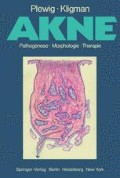Zusammenfassung
Der Kontakt mit einer Vielzahl von Verbindungen kann zu follikulären Reaktionen führen, die in ihrem Ausmaß trivial bis katastrophal sein können. Die initiale Effloreszenz ist in jedem Fall ein Komedo. Deshalb ist Acne venenata eine Spezies des Genus Akne, und nicht eine akneiforme Eruption.
Access this chapter
Tax calculation will be finalised at checkout
Purchases are for personal use only
Preview
Unable to display preview. Download preview PDF.
Literatur
Braun, W.: Chlorakne. Württemberg: Editio Cantor Aulendorf 1955.
Crow, K.D.: Chloracne. A critical review including a comparison of two series of cases of acne from chlor-naphthalene and pitch fumes. Trans. St. John’s Hosp. Derm. Soc. (Lond.) 56, 79–99 (1970).
Fabry, H.: Sogenannte Pechhaut nach Einwirkung von Verbrennungs- und Destillationsprodukten der Kohle. Berufsdermatosen 15, 198–208 (1967).
Forth, W.: Das Unglück von Seveso. Deutsches Ärzteblatt — Ärztliche Mitteilungen 44, 2617–2627 (1977).
Goldmann, P.J.: Schwerste akute Chloracne, eine Massenintoxikation durch 2,3,6,7-Tetrachlordibenzo-dioxin. Hautarzt 24, 149–152 (1973).
Goto, M.: Reports of the study group for “yusho” (chlorobiphenyls poisoning). Fukuoka Acta med. 60, 7–29 (1969).
Kaidbey, K.H., Kligman, A.M.: A human model of coal tar acne. Arch. Derm. 109, 212–215 (1974).
Kimmig, J., Schulz, K.H.: Berufliche Akne (sog. Chlorakne) durch chlorierte aromatische zyklische Äther. Dermatologica (Basel) 115, 540–546 (1957).
Plewig, G.: Zur Kinetik der Comedonen-Bildung bei Chloracne (Halowaxacne). Arch. klin. exp. Derm. 238, 228–241 (1970).
Plewig, G., Braun-Falco, O.: Behandlung von Comedonen bei Morbus Favre-Racouchot und Acne venenata mit Vitamin A-Säure. Hautarzt 22, 341–345 (1971).
Shelley, W.B., Kligman, A.M.: The experimental production of acne by penta- and hexachloronaphtha-lenes. Arch. Derm. Syph. (Chic.) 75, 689–695 (1957).
Weirich, E.G.: Die Kontaktakne: Beispiel einer Zivilisationsdermatose. Teil I, Dermatosen 26, 7–21 (1978).
Weirich, E.G.: Die Kontaktakne: Beispiel einer Zivilisationsdermatose. Teil II, Dermatosen 26, 45–52 (1978).
Author information
Authors and Affiliations
Rights and permissions
Copyright information
© 1978 Springer-Verlag Berlin · Heidelberg
About this chapter
Cite this chapter
Plewig, G., Kligman, A.M. (1978). Acne venenata. In: Akne. Springer, Berlin, Heidelberg. https://doi.org/10.1007/978-3-642-96444-2_22
Download citation
DOI: https://doi.org/10.1007/978-3-642-96444-2_22
Publisher Name: Springer, Berlin, Heidelberg
Print ISBN: 978-3-642-96445-9
Online ISBN: 978-3-642-96444-2
eBook Packages: Springer Book Archive

